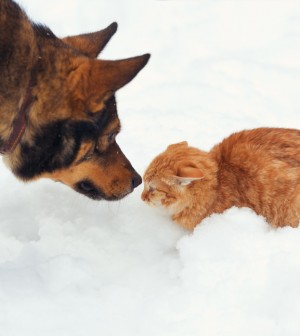- Do you subscribe to Dharma Dog Training’s Newsletter? You should.
- A Unique Campaign from The Humane Society of the United States
- Rabid bats in Omaha- Stay safe, prepared with these tips
- Springtime Activities in Omaha
- Mill Dog Monthly from Bailing Out Benji
- World Spay Day, Legislative Alert in Nebraska
- Attend the Nebraska Rescue Council’s monthly meeting this Saturday
- Five Hard-to-Ignore Reasons to Adopt!
- Paws in Pink to Benefit Breast Cancer Foundation
- VCA, Inc. Acquires MidWest Vet Specialists from Kansas State University
The language of sleep- the what and why of your pet’s bedtime routine

What is the Language behind Dog Sleeping Positions?
Have you ever wondered about the positions in which your pet is sleeping? Emma from The Pet Town, our most recent contributor, says she sees her dog “sleeping in so many positions,” some even weird, so she “can’t help but be curious about it.”
The positions in which pets sleep (or move or twitch) can reveal a lot about them. Also, the amount of sleep they are getting can let you know about their feelings. Every dog has different positions they love to sleep in.
Knowing about body language during and before sleep can give insight into your pet’s moods and happiness level. That’s why you should know about the language behind these sleeping positions.
Read Emma’s post below and learn a bit about how your pet is feeling about you, its environment, and its disposition overall before and during sleep.
Different Sleeping Positions: Know your pet
Always pay attention to how your furry friend sleeps most of the time. It’s because your dog’s sleeping position might change based on his feelings. He could sleep differently near a person or snooze a certain way.
Sometimes hidden sickness or injuries can also alter the sleeping habits of your precious dog. That’s why you should always keep a close eye on him. In case you find anything unusual, look for signs of discomfort or pain.
Check out their sleeping positions below; they will definitely help you out in the long run.
1. The Side
This is one of the comfort positions of your dog. If your dog is sleeping on the side, then he must feel extremely safe and comfortable around you. This position leaves their vital organs exposed.
The position also means that your dog is amiable and easy going. If you see your dog to change this position around people or in a new place, then it’s probably because he’s not comfortable with the change.
This position tends to leave the dog free, and you’ll see more twitching and kicks during the nap time.
2. Curled Into a Ball
This is another common position your dog will sleep in. Dogs often curl up in a ball starting from their tail to nose. This is also another excellent position for wild animals. This position protects their vital organs, make them feel warm and also helps them get up quicker.
This position wraps the arms and legs, so if your dog sleeps in that, you’ll see less twitching and kicking.
You’d think that if a dog is sleeping like that, then he is not comfortable or feels threated. However, this is not the case always. Dogs tend to sleep in this position during fall and winter to preserve the warmth.
On the other hand, your dog might love to sleep in that position.
3. On the Tummy
This position perfectly resembles the “Superman” position. Your dog will be spreading its legs and lie straight on the tummy. This type of position allows them to pop right up whenever they want to.
You’ll see this type of sleeping habits in pups. They are apparently more energetic when young, and they don’t want to miss even a second of the action. Puppies also prefer it because they nap a lot when they are young.
4. Paws in Air
This is a somewhat unusual sleeping position, not to mention its super funny. If you see your dog to sleep in apposition where he is on his back, and all of the legs are in the air, don’t freak out. It’s a healthy position for dogs to sleep in.
However, they serve a unique purpose with this one. As the curled up position preserved warmth, this one actually cools them off during summer times. The fur is thinner on the belly compared to the back.
Also, the sweat glands are on their paws so, exposing these areas helps them to cool off. It says that he is extremely comfortable with you, to the point that he doesn’t shy away from being vulnerable.
It’s a typical scene during hot summer days.
5. Snuggle
Does your dog love to snuggle up to you and sleep? They could also be snuggling up with other dogs or pets. This is a really positive sign of bonding. If he is snuggling with another pet and they are getting to know each other and wants to be comfortable in the process.
A dog sleeping in this position will want affection and love from you. It’s also their way of showing you that they love you. Show some love to your pups, when they do that.
Different Sleeping Behaviors of Dogs
After your dog takes a nap, you’ll be able to check up on him with his sleep behaviors. They tell a lot about your dog’s health and sleeping quality.
1. Circling and Digging
You must have seen your dog circle in the sleeping zone and sometimes even to dig into it before sleeping. This behavior comes from their inner wolf ancestors. Wolves’ lives in the wild and they sleep on leaves, snow, and grass.
They would trample these down to make the sleeping spot more comfortable. Dogs also do that before sleeping, but if it’s too much, then he might have some neurological problem or arthritis. Best to inform a vet.
2. Light Doze Off
Dogs tend to doze off if they are bored and don’t have anything to do. This is not a restful sleep. If you look closely, you’ll see that your dog is still alert and waiting for something interesting to happen.
If you see him like this take him for a walk or play with him.
3. Soft Bark, Wagging, or Twitching
During REM sleep, dogs tend to move a bit. They could bark or wiggle their tail a little. They are just acting out their dream that’s all. It’s really common and a good sign of perfect sleep.
However, sometimes when they twitch their leg, they might be cold. It’s a way to warm up their body. If your dog is cold get him a blanket. This is usually most prominent in elder dogs or puppies.
4. Whimper in Sleep
Like us, dogs too have nightmares. If they start to whimper during sleep or show other signs of distress, just call his name softly or slowly stroke him. Your dog could wake up or just go back to sleep.
5. Seizure
If the twitching gets worse, then it could be a seizure. Right when you see something abnormal going on, immediately seek medical help.
Final Thoughts:
Your beloved dog probably sleeps a lot then you. Dogs need a right amount of sleep every day from 12 to 14 hours. Puppies can go even higher to 18-19 hours!
Now that you know about your dog’s sleep positions, you will finally be able to know exactly what’s going on with your dog.
One last bit of advice: Click the following link if you’re interested in finding out about high-quality orthopedic beds for dogs!
Related Posts
Latest News
-
3 Tips for Pet Owners on Training Rescue Dogs
Owning a rescue dog can take some work compared to...
- Posted 3 weeks ago
- 0
-
Choosing the Right Pet for Your Lifestyle
Are you thinking about getting a pet but unsure what...
- Posted 1 month ago
- 0
-
How to Make Your Rescue Pet as Comfortable as Possible
Did you bring home a new pet from a shelter...
- Posted 2 months ago
- 0
-
How Having A Pet Can Change Your Life
Having a pet can open your heart in ways that...
- Posted 7 months ago
- 0
-
How To Improve The Life Of Your Senior Pet
Do you have an elderly fur baby and want to...
- Posted 8 months ago
- 0
-
Springtime Activities To Enjoy With Your Furry Friends
Are you preparing for warmer weather and want some ideas...
- Posted 9 months ago
- 0
-
Pros And Cons Of Microchipping Your Pets
Have you considered whether your pets should be microchipped and...
- Posted 9 months ago
- 0





















You must be logged in to post a comment Login